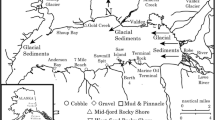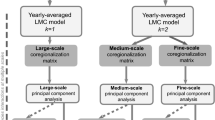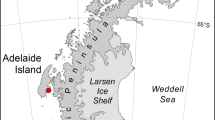Abstract
Marine coasts are dynamic environments where spatial-physical gradients interact with seasonality. In the Patagonia in particular, high temperatures and strong winds lead to stressing physical conditions that shape intertidal communities. In a previous study, we found that the interaction between the sponge Hymeniacidon perlevis and the macroalga Ulva lactuca was context-dependent, switching from positive at the harsher intertidal to negative at the milder subtidal environment. Temporal variation in the physical variables, however, may also affect species performance and interaction strength. Since Patagonian shores are strongly seasonal environments, we evaluated how the interactions (competitive or cooperative) among these two spatially dominant species changed over a temporal-stress gradient throughout a year. We predicted that the macroalga would facilitate the sponge in seasons with more severe environmental conditions, whereas negative or neutral interactions would prevail when environmental conditions were milder. Our results demonstrated that the sign and intensity of the interaction between Hymeniacidon and Ulva changed over the seasons and coincided with a hump-shaped model, involving a neutral interaction in the milder seasons of autumn and winter, then switching to a positive one in the inclement springtime, and finally shifting to a negative relationship in the harshness of the summer. The amelioration of stressful conditions through shading did not satisfactorily explain the underlying mechanism for this varying interaction, an aspect that still remains unclear. Nevertheless, several mechanisms are discussed both within the context of the stress gradient hypothesis and the specific physiological constraints of intertidal organisms.





Similar content being viewed by others
Data availability
The datasets generated and/or analyzed during the current study are available from the corresponding author on reasonable request.
References
Abdo DA, McDonald JI, Harvey ES, Fromont J, Kendrick GA (2008) Neighbour and environmental influences on the growth patterns of two temperate Haliclonid sponges. Mar Freshw Res 59:304–312
Aliotta S, Schnack EJ, Isla FI, Lizasoain GO (2000) Desarrollo secuencial de formas de fondo en un régimen macromareal. Rev Asoc Argent Sedimentol 7:95–107
Archer SK, Stoner EW, Layman CA (2015) A complex interaction between a sponge (Halichondria melanadocia) and a seagrass (Thalassia testudinum) in a subtropical coastal ecosystem. J Exp Mar Biol Ecol 465:33–40
Armas C, Ordiales R, Pugnaire FI (2004) Measuring plant interactions: a new comparative index. Ecology 85:2682–2686
Ayling AL (1983) Growth and regeneration rates in thinly encrusting demospongiae from temperate waters. Biol Bull 165:343–352
Beermann AJ, Ellrich JA, Molis M, Scrosati RA (2013) Effects of seaweed canopies and adult barnacles on barnacle recruitment: the interplay of positive and negative influences. J Exp Mar Biol Ecol 448:162–170
Bell JJ (2008a) The functional roles of marine sponges. Est Coast Shelf Sci 79:341–353
Bell JJ (2008b) Sponges as agents of biological disturbance. Mar Ecol Prog Ser 368:127–135
Bell JJ, Davy SK, Jones T, Taylor MW, Webster NS (2013) Could some coral reefs become sponge reefs as our climate changes? GlobChange Biol 19:2613–2624
Benedetti-Cecchi L, Bertocci I, Vaselli S, Maggi E (2006) Temporal variance reverses the impact of high mean intensity of stress in climate change experiments. Ecology 87:2489–2499
Bennett S, Wernberg T, De Bettignies T, Kendrick GA, Anderson RJ, Bolton JJ, Rodgers KL, Shears NT, Leclerc J-C, Lévêque L (2015) Canopy interactions and physical stress gradients in subtidal communities. Ecol Lett 18:677–686
Bertness MD, Callaway R (1994) Positive interactions in communities. Trends Ecol Evol 9:191–193
Bertness MD, Ewanchuk PJ (2002) Latitudinal and climate-driven variation in the strength and nature of biological interactions in New England salt marshes. Oecologia 132:392–401
Bertness MD, Leonard GH, Levine JM, Schmidt PR, Ingraham AO (1999) Testing the relative contribution of positive and negative interactions in rocky intertidal communities. Ecology 80:2711–2726
Bertness MD, Crain CM, Silliman BR, Bazterrica MC, Reyna M, Hildago F, Farina J (2006) The community structure of western Atlantic Patagonian rocky shores. Ecol Monogr 76:439–460
Biswas SR, Wagner HH (2014) A temporal dimension to the stress gradient hypothesis for intraspecific interactions. Oikos 123:1323–1330
Brooker RW, Callaghan TV (1998) The balance between positive and negative plant interactions and its relationship to environmental gradients: a model. Oikos 81:196–207
Bruno JF, Stachowicz JJ, Bertness MD (2003) Inclusion of facilitation into ecological theory. Trends Ecol Evol 18:119–125
Bulleri F, Cristaudo C, Alestra T, Benedetti-Cecchi L (2011) Crossing gradients of consumer pressure and physical stress on shallow rocky reefs: a test of the stress-gradient hypothesis. J Ecol 99:335–344
Bulleri F, Xiao S, Maggi E, Benedetti-Cecchi L (2014) Intensity and temporal variability as components of stress gradients: implications for the balance between competition and facilitation. Oikos 123:47–55
Cabrera AL (1976) Regiones fitogeográficas argentinas. In: Kugler WF (ed) Enciclopedia argentina de agricultura y jardinería. Tomo 2, 2nd edn. Acme, Buenos Aires, pp 1–85
Canepuccia AD, Pérez CF, Farina JL, Alemany D, Iribarne OO (2013) Dissimilarity in plant species diversity between salt marsh and neighboring environments decreases as environmental harshness increases. Mar Ecol Prog Ser 494:135–148
Cao X, Fu W, Yu X, Zhang W (2007) Dynamics of spicule production in the marine sponge Hymeniacidon perlevis during in vitro cell culture and seasonal development in the field. Cell Tissue Res 329:595–608
Carballo JL, Avila E, Enríquez S, Camacho L (2006) Phenotypic plasticity in a mutualistic association between the sponge Haliclona caerulea and the calcareous macroalga Jania adherens induced by transplanting experiments. I: morphological responses of the sponge. Mar Biol 148:467–478
Cárdenas CA, Davy SK, Bell JJ (2016) Influence of canopy-forming algae on temperate sponge assemblages. J Mar Biol Assoc UK 96:351–362
Clarke A (1983) Life in cold water: the physiological ecology of polar marine ectotherms. Oceanogr Mar Biol 21:341–453
Crotty SM, Bertness MD (2015) Positive interactions expand habitat use and the realized niches of sympatric species. Ecology 96:2575–2582
Cubit JD (1984) Herbivory and the seasonal abundance of algae on a high intertidal rocky shore. Ecology 65:1904–1917
Dayton PK (1971) Competition, disturbance, and community organization: the provision and subsequent utilization of space in a rocky intertidal community. Ecol Monogr 41:351–389
de Goeij JM, Lesser MP, Pawlik JR (2017) Nutrient fluxes and ecological functions of coral reef sponges in a changing ocean. In: Carballo J, Bell J (eds) Climate change, ocean acidification and sponges. Springer, Cham, pp 373–410
De Mendiburu F, Simon R (2015) Agricolae-ten years of an open source statistical tool for experiments in breeding, agriculture and biology. Peer J (preprints)
Deutsch CA, Tewksbury JJ, Huey RB, Sheldon KS, Ghalambor CK, Haak DC, Martin PR (2008) Impacts of climate warming on terrestrial ectotherms across latitude. Proc Natl Acad Sci USA 105:6668–6672
Easson CG, Slattery M, Baker DM, Gochfeld DJ (2014) Complex ecological associations: competition and facilitation in a sponge–algal interaction. Mar Ecol Prog Ser 507:153–167
Eckman JE, Duggins DO (1991) Life and death beneath macrophyte canopies: effects of understory kelps on growth rates and survival of marine, benthic suspension feeders. Oecologia 87:473–487
Elvin DW (1976) Seasonal growth and reproduction of an intertidal sponge, Haliclona permollis (Bowerbank). Biol Bull 151:108–125
Fox J, Weisberg S (2011) Multivariate linear models in R. An appendix to an R companion to applied regression, 2nd edn. Sage Publications, Thousand Oaks
Gastaldi M, Firstater FN, Daleo P, Narvarte MA (2016) Abundance of the sponge Hymeniacidon cf. perlevis in a stressful environment of Patagonia: relationships with Ulva lactuca and physical variables. J Mar Biol Assoc UK 96:465–472
Gastaldi M, Firstater FN, Narvarte MA, Daleo P (2017) Context-dependent interaction between an intertidal sponge and a green macroalga in a variable temperate Patagonian bay. Mar Ecol Prog Ser 581:21–32
Genchi SA, Carbone ME, Piccolo MC, Perillo ME (2010) Déficit hídrico en San Antonio Oeste, Argentina. Rev Climatol 10:29–43
González-Rivero M, Ferrari R, Schönberg CH, Mumby PJ (2012) Impacts of macroalgal competition and parrotfish predation on the growth of a common bioeroding sponge. Mar Ecol Prog Ser 444:133–142
Helmuth BS, Hofmann GE (2001) Microhabitats, thermal heterogeneity, and patterns of physiological stress in the rocky intertidal zone. Biol Bull 201:374–384
Hidalgo FJ, Silliman BR, Bazterrica MC, Bertness MD (2007) Predation on the rocky shores of Patagonia, Argentina. Estuar Coast 30:886–894
Hofmann GE, Todgham AE (2010) Living in the now: physiological mechanisms to tolerate a rapidly changing environment. Annu Rev Physiol 72:127–145
Holmgren M, Scheffer M (2010) Strong facilitation in mild environments: the stress gradient hypothesis revisited. J Ecol 98:1269–1275
Hothorn T, Bretz F, Westfall P (2008) Simultaneous inference in general parametric models. Biomet J 50:346–363
Jones CG, Lawton JH, Shachak M (1997) Positive and negative effects of organisms as physical ecosystem engineers. Ecology 78:1946–1957
Kissling WD, Dormann CF, Groeneveld J, Hickler T, Kühn I, McInerny GJ, Montoya JM, Römermann C, Schiffers K, Schurr FM (2012) Towards novel approaches to modelling biotic interactions in multispecies assemblages at large spatial extents. J Biogeogr 39:2163–2178
Kordas RL, Harley CD, O’Connor MI (2011) Community ecology in a warming world: the influence of temperature on interspecific interactions in marine systems. J Exp Mar Biol Ecol 400:218–226
Lenth RV (2016) Least-squares means: the R package lsmeans. J Stat Softw 69:1–33
Leonard GH (2000) Latitudinal variation in species interactions: a test in the New England rocky intertidal zone. Ecology 81:1015–1030
Lucas AJ, Guerrero RA, Mianzan HW, Acha EM, Lasta CA (2005) Coastal oceanographic regimes of the northern argentine continental shelf (34–43 S). Estuar Coast Shelf Sci 65:405–420
Maestre FT, Callaway RM, Valladares F, Lortie CJ (2009) Refining the stress-gradient hypothesis for competition and facilitation in plant communities. J Ecol 97:199–205
Malkinson D, Tielbörger K (2010) What does the stress-gradient hypothesis predict? Resolving the discrepancies. Oikos 119:1546–1552
Martinetto P, Daleo P, Escapa M, Alberti J, Isacch JP, Fanjul E, Botto F, Piriz ML, Ponce G, Casas G et al (2010) High abundance and diversity of consumers associated with eutrophic areas in a semi-desert macrotidal coastal ecosystem in Patagonia, Argentina. Estuar Coast Shelf Sci 88:357–364
Menge BA, Branch GM (2001) Rocky intertidal communities. In: Bertness MD, Gaines SD, Hay ME (eds) Marine community ecology. Sinauer Associates, Inc., Sunderland, pp 221–251
Menge BA, Sutherland JP (1976) Species diversity gradients: synthesis of the roles of predation, competition, and temporal heterogeneity. Am Nat 110:351–369
Menge BA, Sutherland JP (1987) Community regulation: variation in disturbance, competition, and predation in relation to environmental stress and recruitment. Am Nat 130:730–757
Michalet R, Brooker RW, Cavieres LA, Kikvidze Z, Lortie CJ, Pugnaire FI, Valiente-Banuet A, Callaway RM (2006) Do biotic interactions shape both sides of the humped-back model of species richness in plant communities? Ecol Lett 9:767–773
Michalet R, Le Bagousse-Pinguet Y, Maalouf J-P, Lortie CJ (2014) Two alternatives to the stress-gradient hypothesis at the edge of life: the collapse of facilitation and the switch from facilitation to competition. J Veg Sci 25:609–613
Nelson TA, Lee DJ, Smith BC (2003) Are “green tides” harmful algal blooms? Toxic properties of water-soluble extracts from two bloom-forming macroalgae, Ulva fenestrata and Ulvaria obscura (Ulvophyceae). J Phycol 39:874–879
Pallela R, Ehrlich H (2016) Marine sponges: chemicobiological and biomedical applications. Springer, New Delhi
Pawlik JR, Loh T-L, McMurray SE, Finelli CM (2013) Sponge communities on Caribbean coral reefs are structured by factors that are top-down, not bottom-up. PLoS ONE 8:e62573
Petes LE, Menge BA, Murphy GD (2007) Environmental stress decreases survival, growth, and reproduction in New Zealand mussels. J Exp Mar Biol Ecol 351:83–91
R Core Team (2020) R: A language and environment for statistical computing. R Foundation for Statistical Computing, Vienna, Austria. https://www.R-project.org/
Rützler K (1978) Sponges in coral reefs. In: Stoddart DR, Johannes RE (eds) Coral reefs: research methods: monographs on oceanographic methodology. No 5. UNESCO, Paris, pp 299–314
Sanders HL (1968) Marine benthic diversity: a comparative study. Am Nat 102:243–282
Schneider CA, Rasband WS, Eliceiri KW (2012) NIH image to ImageJ: 25 years of image analysis. Nat Methods 9:671
Scrosati RA, Ellrich JA (2018) Thermal moderation of the intertidal zone by seaweed canopies in winter. Mar Biol 165:115
Silliman BR, Bertness MD, Altieri AH, Griffin JN, Bazterrica MC, Hidalgo FJ, Crain CM, Reyna MV (2011) Whole-community facilitation regulates biodiversity on Patagonian rocky shores. PLoS ONE 6:e24502
Smit C, Rietkerk M, Wassen MJ (2009) Inclusion of biotic stress (consumer pressure) alters predictions from the stress gradient hypothesis. J Ecol 97:1215–1219
Stone AR (1970) Growth and reproduction of Hymeniacidon perleve (Montagu) (Porifera) in langstone harbour hampshire. J Zool 161:443–459
Teichberg M, Fox SE, Olsen YS, Valiela I, Martinetto P, Iribarne O, Muto EY, Petti MA, Corbisier TN, Soto-Jiménez M et al (2010) Eutrophication and macroalgal blooms in temperate and tropical coastal waters: nutrient enrichment experiments with Ulva spp. Glob Change Biol 16:2624–2637
Tomanek L, Helmuth B (2002) Physiological ecology of rocky intertidal organisms: a synergy of concepts. Integr Comp Biol 42:771–775
Trygonis V, Sini M (2012) photoQuad: a dedicated seabed image processing software, and a comparative error analysis of four photoquadrat methods. J Exp Mar Biol Ecol 424:99–108
Uyà M, Bulleri F, Wright JT, Gribben PE (2020) Facilitation of an invader by a native habitat-former increases along interacting gradients of environmental stress. Ecology 101:e02961
Valiela I, McClelland J, Hauxwell J, Behr PJ, Hersh D, Foreman K (1997) Macroalgal blooms in shallow estuaries: controls and ecophysiological and ecosystem consequences. Limnol Oceanogr 42:1105–1118
van Hees DH, Van Alstyne KL (2013) Effects of emersion, temperature, dopamine, and hypoxia on the accumulation of extracellular oxidants surrounding the bloom-forming seaweeds Ulva lactuca and Ulvaria obscura. J Exp Mar Biol Ecol 448:207–213
Watt CA, Scrosati RA (2013a) Bioengineer effects on understory species richness, diversity, and composition change along an environmental stress gradient: experimental and mensurative evidence. Estuar Coast Shelf Sci 123:10–18
Watt CA, Scrosati RA (2013b) Regional consistency of intertidal elevation as a mediator of seaweed canopy effects on benthic species richness, diversity, and composition. Mar Ecol Prog Ser 491:91–99
Wickham H (2016) ggplot2: elegant graphics for data analysis. Springer, Berlin
Wilke CO (2019) Cowplot: streamlined plot theme and plot. Annotations for 'ggplot2'. R package version 1.0.0. https://CRAN.R-project.org/package=cowplot
Wright A, Schnitzer SA, Reich PB (2015) Daily environmental conditions determine the competition–facilitation balance for plant water status. J Ecol 103:648–656
Wulff J (2001) Assessing and monitoring coral reef sponges: why and how? Bull Mar Sci 69:831–846
Wulff J (2012) Ecological interactions and the distribution, abundance, and diversity of sponges. Adv Mar Biol 61:273
Zar JH (1999) Biostatistical analysis. Prentice-Hall, Englewood Cliffs
Acknowledgements
We wish to thank Michael Lesser, Brian Silliman, Pedro Daleo, the associated editor Fabio Bulleri, and the three anonymous reviewers whose suggestions have made a significant improvement in the manuscript. We also are grateful to Maité Barrena, María Cecilia Salas, Giuliana Burgueño, and Macarena Valiñas for their help during samplings, and to Matías Ocampo-Reinaldo for his guidance in performing the R plots. Dr. Donald F. Haggerty, a retired academic career investigator and native English speaker, edited the final version of the manuscript.
Funding
M.G. was supported by a CONICET postdoctoral scholarship (https://www.CONICET.gob.ar). This study was partially supported by MG scholarship and the PIP-CONICET #112-201501-0465 to MN and FF.
Author information
Authors and Affiliations
Contributions
MG and FNF conceived of the idea and designed the study, MG collected the data, and MG and MAR analyzed the data. MG wrote the manuscript. MAR wrote part of the M-&-M section. FNF, PJP, and MAN assisted in the writing of the draft. All the authors assisted in the field, contributed critically to the drafts, and gave final approval for publication.
Corresponding author
Ethics declarations
Conflict of interest
The authors declare that they have no conflict of interest. All the authors consented to and agreed to carry out this research. The Argentine national guidelines for the sampling, care, and experimental use of organisms for the study have been followed and the necessary approvals obtained.
Additional information
Responsible Editor: F. Bulleri.
Reviewed by: G.M. Martins and undisclosed experts.
Publisher's Note
Springer Nature remains neutral with regard to jurisdictional claims in published maps and institutional affiliations.
Rights and permissions
About this article
Cite this article
Gastaldi, M., Firstater, F.N., Romero, M.A. et al. Seasonality dictates changes in the ecological interactions among spatial dominants. Mar Biol 167, 176 (2020). https://doi.org/10.1007/s00227-020-03791-x
Received:
Accepted:
Published:
DOI: https://doi.org/10.1007/s00227-020-03791-x




